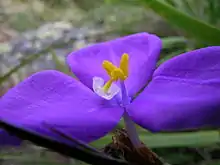Patersonia
Patersonia is a genus of flowering plants in the family Iridaceae commonly known as native iris or native flag.[2] It was first described as a genus in 1807 by Robert Brown.[3] It is native to Australia, New Guinea, New Caledonia, and insular Southeast Asia.[1][4] The genus name is a tribute to the first Lieutenant Governor of New South Wales in Australia, William Paterson.[5]
| Patersonia | |
|---|---|
 | |
| Patersonia sericea | |
| Scientific classification | |
| Kingdom: | Plantae |
| Clade: | Tracheophytes |
| Clade: | Angiosperms |
| Clade: | Monocots |
| Order: | Asparagales |
| Family: | Iridaceae |
| Subfamily: | Patersonioideae Goldblatt |
| Genus: | Patersonia R.Br. |
| Type species | |
| Patersonia sericea R.Br. | |
| Synonyms[1] | |
| |
They are perennials with basal leaves growing from a woody rhizome that in some species extends above ground to form a short trunk. The leaves are tough and fibrous, often with adaptations for conserving moisture, such as stomata sunk in grooves, a thickened cross-section, marginal hairs, and thickened margins.
The flowers appear from between a pair of bracts on a leafless stem. They have three large outer tepals that are usually blue to violet, and three tiny inner tepals. There are three stamens fused at the base to form a tube around the longer style, which bears a flattened stigma.[6]
Several Patersonia species are grown as garden plants. They can be propagated by seed or by division.
- Species[1]
- Patersonia argyrea D.A.Cooke - Gairdner Range in Western Australia
- Patersonia babianoides Benth. - Western Australia
- Patersonia borneensis Stapf - Sabah
- Patersonia drummondii F.Muell. ex Benth. - Western Australia
- Patersonia fragilis (Labill.) Asch. & Graebn. - swamp iris, a plant of sandy coastal heathlands in south-eastern Australia (southern Queensland to Tasmania); it has narrow, grey-green leaves and pale violet flowers close to the ground
- Patersonia glabrata R.Br. - Queensland, New South Wales, Victoria - leafy purple flag, bugulbi (Cadigal), a shrub up to 80 cm high with wiry, tangled stems
- Patersonia graminea Benth. - Western Australia
- Patersonia inaequalis Benth. - Western Australia
- Patersonia inflexa Goldblatt - Papua New Guinea
- Patersonia juncea Lindl. - Western Australia
- Patersonia lanata R.Br. - Western Australia
- Patersonia limbata Endl. - Stirling Range in Western Australia
- Patersonia lowii Stapf - Sabah
- Patersonia macrantha Benth. - Northern Territory of Australia
- Patersonia maxwellii (F.Muell.) F.Muell. ex Benth. - Western Australia
- Patersonia neocaledonica Goldblatt & J.C.Manning - New Caledonia
- Patersonia novo-guineensis Gibbs - Arfak Mountains in Province of West Papua in Indonesia
- Patersonia occidentalis R.Br., which grows up to 75 cm tall and has blue flowers. It is widespread in southern Australia (South Australia, Victoria, Tasmania, Western Australia)
- Patersonia philippinensis Goldblatt - Mindoro Island in Philippines
- Patersonia pygmaea Lindl. - Western Australia
- Patersonia rudis Endl. - Western Australia
- Patersonia sericea R.Br. New South Wales
- Patersonia spirafolia Keighery - Western Australia
- Patersonia sumatrensis Goldblatt - Sumatra
- Patersonia umbrosa Endl. , a species from Western Australia that has two colour variants, the typical blue-violet variety, and the yellow-flowered var. xanthina from the karri forests
References
- Kew World Checklist of Selected Plant Families
- "Patersonia species" on the Australian national herbarium web site
- "Patersonia R.Br". Australian Plant Name Index (APNI), IBIS database. Centre for Plant Biodiversity Research, Australian Government.
- Cooke, D. A. (1986). Patersonia. Flora of Australia 46: 13-26. Australian Government Publishing Service, Canberra.
- Manning, J. and P. Goldblatt (2008). The Iris Family: Natural History & Classification. Portland, Oregon: Timber Press. pp. 94–95. ISBN 0-88192-897-6.
- Goldblatt, P. (2011). Systematics of Patersonia (Iridaceae, Patersonioideae) in the Malesian archipelago. Annals of the Missouri Botanical Garden 98: 514-523.